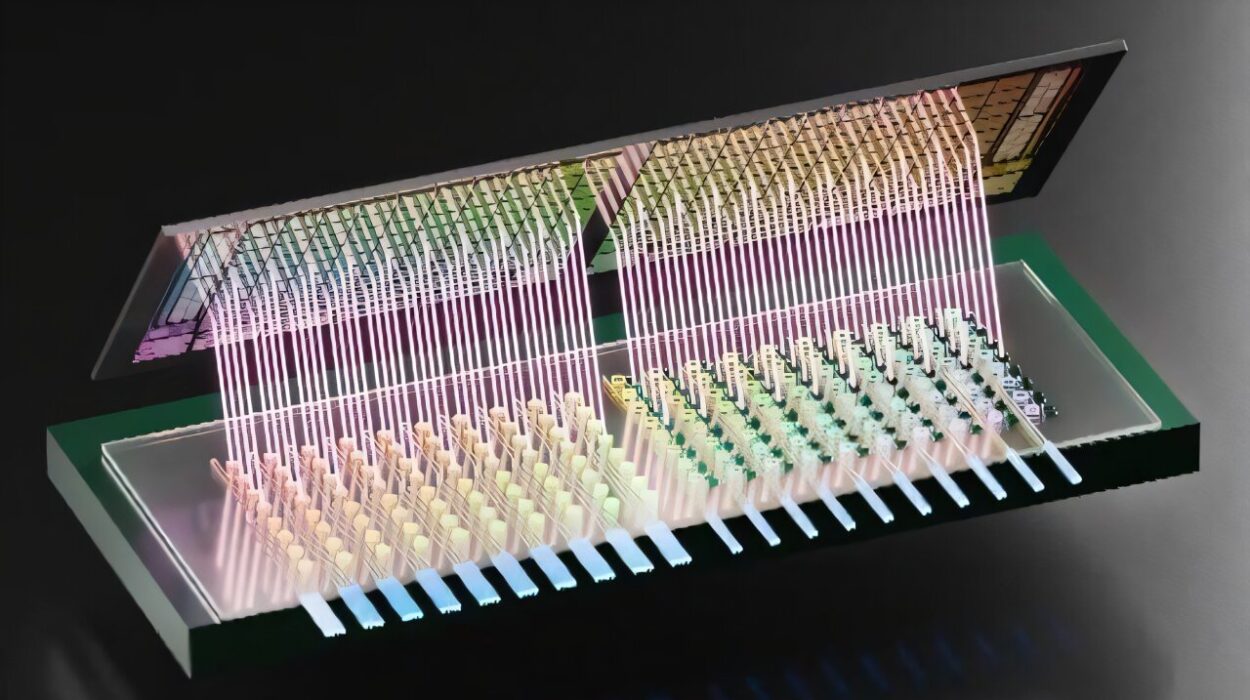For over half a century, computers have been powered by the flow of electricity—tiny streams of electrons racing through silicon circuits. This has been the foundation of our digital age, fueling everything from smartphones to supercomputers. But as our hunger for faster, more efficient computing grows, traditional electronics are reaching their physical limits. Heat, energy consumption, and the finite speed of electrons are now pressing barriers.
Enter light-based computing—a bold new frontier where photons, not electrons, carry information. Unlike electrical signals, photons move at the speed of light and generate almost no heat, promising unprecedented processing power and energy efficiency. Imagine computers that could perform complex calculations in a fraction of the time and consume a fraction of the energy. It sounds like science fiction, but this is the reality researchers are now beginning to shape.
Yet, as with every great scientific leap, the path to light-based computing is not without obstacles. Among the most significant challenges is how to guide and control light efficiently on microscopic chips. And this is where a fascinating new discovery—gyromorphs—may change everything.
The Challenge of Harnessing Light
To build a computer powered by light, scientists must create pathways and barriers that precisely steer photons—just as traditional computers use wires and transistors to guide electrons. But unlike electrons, photons are elusive. They scatter, diffract, and reflect in unpredictable ways. Keeping their signals strong and stable requires materials capable of blocking stray light from every possible direction—a property known as an isotropic bandgap.
Creating such a material has been a decades-long challenge. The material must be lightweight, precisely structured, and able to control light in all directions without absorbing it. Most known materials can only block light from specific angles, weakening the overall signal and reducing computing efficiency.
Researchers have long turned to quasicrystals to address this problem. First theorized by physicists Paul Steinhardt and Dov Levine in the 1980s and discovered experimentally by Dan Shechtman—a discovery that won him the 2011 Nobel Prize in Chemistry—quasicrystals possess an unusual form of order. Their atomic arrangement follows mathematical rules but never repeats, creating a unique geometry.
Quasicrystals can block light efficiently in certain directions. However, they face a trade-off: if they block light completely, they do so only from a few angles; if they scatter light from all angles, they fail to block it entirely. That delicate balance has kept light-based computing tantalizingly out of reach—until now.
The Birth of a New Material: Gyromorphs
In groundbreaking research published in Physical Review Letters, scientists at New York University (NYU) announced the discovery of a new type of material that could overcome this longstanding limitation. They call it gyromorphs—a term as novel as the material itself.
“Gyromorphs are unlike any known structure,” explains Stefano Martiniani, an assistant professor of physics, chemistry, mathematics, and neural science at NYU and the paper’s senior author. “Their unique makeup gives rise to better isotropic bandgap materials than is possible with current approaches.”
So what makes gyromorphs so special? They combine two seemingly incompatible qualities: the order of crystals and the fluidity of liquids. Their structure behaves like a liquid up close—flexible, dynamic, and disordered—but when viewed from a larger scale, patterns emerge that resemble regular crystal formations. This delicate balance between order and randomness allows gyromorphs to block light equally well from all directions, solving one of the most persistent challenges in photonic materials.
Order, Chaos, and the Art of Controlled Disorder
To understand gyromorphs, it helps to think of a forest. Trees don’t grow in perfect lines, but they also aren’t scattered completely at random. Each tree maintains some distance from the others, creating a natural pattern—a balance of order and randomness.
This is how Mathias Casiulis, a postdoctoral fellow at NYU and the lead author of the paper, describes the essence of gyromorphs. “This new pattern combines properties that we believed to be incompatible and displays a function that outperforms all ordered alternatives, including quasicrystals,” he says.
The NYU team achieved this breakthrough by using advanced algorithms to design metamaterials—engineered materials whose properties arise not from their chemical composition, but from their internal structure. By tweaking the spatial arrangement of microscopic elements, they created a new type of “correlated disorder,” a structure that’s neither fully random nor fully regular.
The result was astonishing: a material capable of completely blocking unwanted light in every direction while allowing desired signals to pass through cleanly. Gyromorphs, in effect, act like perfect filters for light—a crucial step toward building practical light-based computer chips.
The Promise of Photonic Computers
Light-based computing, or photonic computing, represents one of the most promising technological revolutions of the 21st century. Unlike electronic circuits, which move electrons through resistive materials, photonic circuits use light to carry information almost instantly, with minimal loss of energy.
In practice, this means computers that are exponentially faster and vastly more energy-efficient than anything we have today. They could revolutionize industries that rely on massive data processing—artificial intelligence, quantum simulation, weather modeling, cryptography, and even neuroscience.
But to realize this vision, scientists need materials that can manipulate light as easily as electronics manipulate electricity. This is where gyromorphs enter the story—not just as a theoretical innovation, but as a real-world solution to a fundamental problem.
“Every isotropic bandgap material we tested had a structural signature in common,” says Casiulis. “We wanted to make this signature as pronounced as possible. The result was a new class of materials—gyromorphs—that reconcile seemingly incompatible features.”
By combining the fluid irregularity of liquids with the global symmetry of crystals, gyromorphs provide a stable yet flexible environment for photons to travel. This makes them an ideal foundation for constructing optical circuits that can handle light signals with unprecedented precision.
How Gyromorphs Could Transform Technology
If light-based computing becomes practical, it could alter the technological landscape in ways as profound as the invention of the microprocessor. Computers could perform tasks thousands of times faster while consuming far less energy—a vital advantage in an age where data centers already account for a significant portion of global energy use.
In fields like machine learning and artificial intelligence, where vast quantities of data are processed simultaneously, photonic computing could drastically accelerate performance. Likewise, quantum computing—which relies on fragile quantum states of light—could benefit from materials like gyromorphs that maintain signal integrity across multiple directions and scales.
Beyond computing, gyromorphs could revolutionize telecommunications, enabling faster, more efficient data transmission over optical networks. They might also lead to better imaging systems, advanced sensors, and even novel photonic materials for aerospace and defense technologies.
In essence, gyromorphs could become the building blocks of the next technological revolution—a leap from electrons to photons, from heat-laden silicon to the cool precision of light.
The Science of Possibility
At its core, the discovery of gyromorphs is a story of imagination meeting computation. It shows how algorithms, materials science, and physics can converge to create something entirely new—a material that behaves in ways nature never intended.
The team’s work is not just about creating a new substance; it’s about rethinking how structure itself defines function. By exploring the gray area between order and chaos, they’ve revealed a universe of possibilities that may reshape how we design everything from microchips to metamaterials.
“Gyromorphs demonstrate that disorder isn’t always a flaw—it can be a feature,” says Martiniani. “Nature often hides its most powerful designs in what seems like randomness. Once we learn to understand that language, we can start creating structures that even nature never dreamed of.”
The Road Ahead
Though the discovery is groundbreaking, gyromorph-based technology is still in its infancy. The next steps will involve testing how these materials perform under real-world conditions—how they handle intense light, heat, and the complex demands of modern computation.
But the potential is undeniable. The creation of gyromorphs marks the beginning of a new paradigm in photonic materials—a bridge between physics and technology, between theoretical beauty and practical innovation.
As graduate student Aaron Shih, a co-author of the study, notes, “We’re just scratching the surface. There’s a vast landscape of structures and properties we’ve yet to explore.”
A Future Written in Light
For centuries, humanity has used fire, steam, and electricity to power its progress. Now, we stand at the edge of another great transformation—one where light itself becomes the engine of computation.
The discovery of gyromorphs offers a glimpse into that luminous future: computers that process information at the speed of light, materials that blend order and chaos with perfect harmony, and a new generation of technology that mimics the elegance of nature’s own designs.
In a world increasingly defined by the quest for speed, efficiency, and sustainability, gyromorphs represent more than a scientific milestone—they are a symbol of what happens when curiosity meets creativity, and when physics dares to dream in color.
If the 20th century belonged to electricity, the 21st may very well belong to light. And in that shining future, gyromorphs could be the key that unlocks the next great revolution in computing.
More information: Mathias Casiulis et al, Gyromorphs: A New Class of Functional Disordered Materials, Physical Review Letters (2025). DOI: 10.1103/gqrx-7mn2. On arXiv: DOI: 10.48550/arxiv.2410.09023






